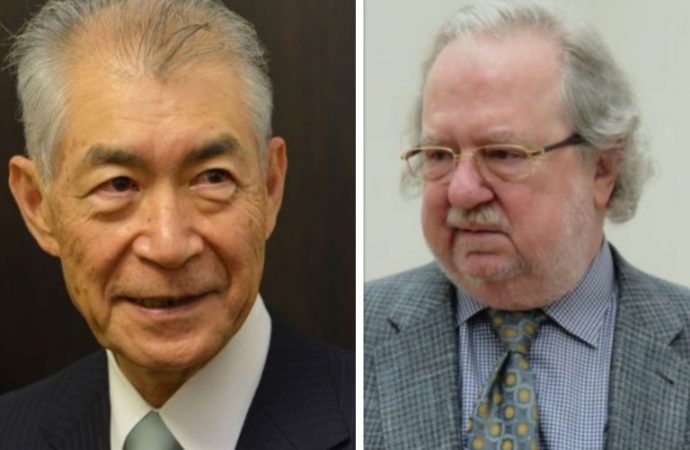This year‘s Nobel Prize in Physiology or Medicine was awarded to James P. Allison and Tasuku Honjo. The two researchers spent most of their careers trying to understand the immune system and how immune mechanisms can inhibit tumour progression.
[wp-svg-icons icon=”point-right” wrap=”span”] Press Release by the Nobel Committee
The immune system is our best ally in the protection against “non-self” molecules or, in other words, intruders who target our cells and weaken our bodies. Sometimes, however, the immune system can be our worst enemy, when it attacks “self” molecules, resulting in an uncontrolled attack on our healthy cells and leading to autoimmune diseases. T cells, in particular, are immune cells specialised in distinguishing between healthy cells and foreigner organisms, and, hopefully, kill only the last. In order to keep this tight balance, T cells rely on “accelerators” and “brakes”, which control the activation, proliferation and function of T cells.
At the beginning of the 20th century, scientists explored the possibility of using the immune system to target cancer cells. The task was difficult: cancer has various and complex ways to circumvent the immune system’s attacks, and, thus, the efforts to create effective strategies to prevent cancer growth in humans proved challenging.
Checkpoint Inhibitors
In the 90s, Allison and Honjo worked, in parallel, with T cells. James P. Allison, born in Texas, USA, in 1948, investigated the T-cell molecule CTLA-4. Allison and his colleagues found that CTLA-4 functions as a downregulator, or “brake”, of the immune system – when it binds to other molecules, CTLA-4 sends an inhibitory signal to T cells, thus preventing their activation. What Allison decided to investigate was whether he could, in cancer patients, block the activity of CTLA-4 using antibodies; the blockade of CTLA-4 would cut short the inhibitory signal to T cells and prompt its activation and targeting of cancer cells. His experiments proved that the blockade of the CTLA-4 molecule in mice with cancer lead to a significant decrease in tumour cells and drawn further studies and clinical trials in humans; the immunotherapy has proved particularly important for people with advanced melanoma, who show extraordinary improvements.
At around the same time, in 1982, the Japanese scientist Tasuku Honjo first identified the Programed Cell-Death Protein 1 (PD-1), a molecule that, as CTLA-4, suppresses the activation and function of T cells. Similarly to CTLA-4 blockade, the inhibition of PD-1 by antibodies has resulted in a promising strategy to avert cancer cell proliferation.
Cancer immunotherapy has come a long way since the 90s. But the work of these two researchers was fundamental in raising the pillars of our current knowledge about how the immune system works to fight cancer.
Articles available in the Open Access Library:
James P Allison:
Jenq, Robert R., et al. “Repertoire enhancement with adoptively transferred female lymphocytes controls the growth of pre-implanted murine prostate cancer.” PloS one 7.4 (2012): e35222.
Curran, Michael A., et al. “Combination CTLA-4 blockade and 4-1BB activation enhances tumor rejection by increasing T-cell infiltration, proliferation, and cytokine production.” PloS one6.4 (2011): e19499.
Tasuku Honjo:
Hisajima, Hiroshi, et al. “Structure of the human immunoglobulin C epsilon 2 gene, a truncated pseudogene: implications for its evolutionary origin.” Proceedings of the National Academy of Sciences 80.10 (1983): 2995-2999.
Kobayashi, Maki, et al. “In vivo analysis of Aicda gene regulation: a critical balance between upstream enhancers and intronic silencers governs appropriate expression.” PLoS One 8.4 (2013): e61433.
Qin, Hongyan, et al. “Activation-induced cytidine deaminase expression in CD4+ T cells is associated with a unique IL-10-producing subset that increases with age.” PloS one 6.12 (2011): e29141.
Image Credits:
James P Allison Photo: Gerbil / Wikimedia Commons
Tasuku Honjo Photo: 平成25年度 文化勲章受章者:文部科学省 / Wikimedia Commons





